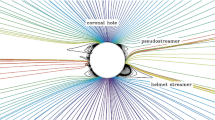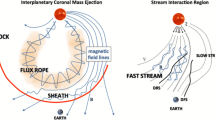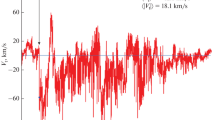Abstract
The geometrical and dynamical structure of a corona consisting of streamer and interstreamer regions is examined. The present paper is an extension of previous works of this series in that energy transport processes are included in the theoretical framework of the model. Under specified conditions at some reference level above the coronal base, the structure at larger distances is determined by simultaneous integration of the continuity, momentum, and energy equations for each region subject to the condition for a lateral balance of magnetic and gas pressure at all levels. Outward thermal conduction and convection by the solar wind are assumed to be the processes contributing to the energy balance of each region, the magnetic field effectively thermally insulating one region from the other.
Numerical results are presented for situations representative of the solar corona. Regions occupied by streamers are found to have higher densities than their surroundings at all distances from the sun. For a given density at the coronal base, the density at the orbit of earth is lower in both the streamer and interstreamer region than that predicted for radial flow. The density enhancement increases outward to a maximum value at a distance of several solar radii. In addition, beyond a distance of a few radii streamers are characterized by higher expansion velocities and lower temperatures than their immediate surroundings. Similar to the case of radial flow, supersonic solutions exist only for base densities below a certain value, which depends upon the specified base temperature and magnetic field distribution. The general features illustrated by these models are expected to persist in the advent of more sophisticated multi-region models.
Similar content being viewed by others
References
Alexander, J. K., Malitson, H. H., and Stone, R. G.: 1968, Preprint,Solar Phys. 8, 388.
Alfvén, H.: 1947,Monthly Notices Roy. Astron. Soc. 107, 211.
Altschuler, M. D. and Newkirk, G. A.: 1969,Solar Phys. 9, 131.
Brandt, J. C., Wolff, C., and Cassinelli, J. P.: 1969,Astrophys. J. 156, 1117.
Chapman, S.: 1954,Astrophys. J. 120, 151.
Ferraro, V. C. and Bhatia, V. B.: 1967,Astrophys. J. 147, 220.
Hartz, T. R.: 1969,Planetary Space Sci. 17, 267.
Hepburn, N.: 1955,Astrophys. J. 122, 445.
Hundhausen, A. J.: 1968,Space Sci. Rev. 8, 690.
Koomen, M. J., Seal, R. T., and Tousey, R.: 1969, Paper presented at the Special Meeting on Solar Astronomy of the American Astronomical Society, Pasadena, Calif.
Kuperus, M.: 1969,Space Sci. Rev. 9, 713.
Michard, R.: 1954,Ann. Astrophys. 17, 429.
Modisette, J. L.: 1967,J. Geophys. Res. 72, 1521.
Newkirk, G. A.: 1967,Ann. Rev. Astron. Astrophys., Vol. V, Annual Reviews Inc.
Newkirk, G. A. and Altschuler, M. D.: 1970,Solar Phys. 13, 131.
Newkirk, G. A., Altschuler, M. D., and Harvey, J. W.: 1968, inStructure and Development of Solar Active Regions (ed. by K. O. Kiepenheuer),IAU Symp. 35, D. Reidel Publ. Co., Dordrecht, Holland, p. 379.
Noble, L. M. and Scarf, F. L.: 1963,Astrophys. J. 138, 1169.
Osterbrock, D. E.: 1961,Astrophys. J. 134, 347.
Parker, E. N.: 1960,Astrophys. J. 132, 821.
Parker, E. N.: 1964,Astrophys. J. 139, 93.
Parker, E. N.: 1965,Astrophys. J. 141, 1463.
Pneuman, G. W.: 1966,Astrophys. J. 145, 800.
Pneuman, G. W.: 1968,Solar Phys. 3, 578.
Pneuman, G. W.: 1969,Solar Phys. 6, 255.
Ramberg, J. M.:Stockholms Obs. Ann. 17, 1951.
Saito, K.: 1959,Publ. Astron. Soc. Japan 11, 234.
Saito, K. and Billings, D. E.: 1964,Astrophys. J. 140, 760.
Saito, K. and Owaki, N.: 1967,Publ. Astron. Soc. Japan 19, 535.
Slysh, V. I.: 1967,Astron. Zh. 44, 487 (Soviet Astron. 11, 389).
Waldmeier, M.: 1963,Z. Astrophys. 56, 291.
Weber, E. J. and Davis, L.: 1967,Astrophys. J. 148, 217.
Whang, Y. C., Liu, C. K., and Chang, C. C.: 1966,Astrophys. J. 145, 255.
Wilcox, J. M.: 1968,Space Sci. Rev. 8, 258.
Author information
Authors and Affiliations
Additional information
The National Center for Atmospheric Research is sponsored by the National Science Foundation.
Rights and permissions
About this article
Cite this article
Pneuman, G.W., Kopp, R.A. Coronal streamers. Sol Phys 13, 176–193 (1970). https://doi.org/10.1007/BF00963950
Received:
Issue Date:
DOI: https://doi.org/10.1007/BF00963950




